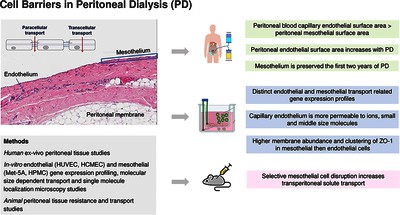Marinovic, Iva and Bartosova, Maria and Lévai, Eszter and Herzog, Rebecca and Saleem, Arslan and Du, Zhiwei and Zhang, Conghui and Sacnum, Juan Manuel and Pitaraki, Eleanna and Sinis, Sotirios and Damgov, Ivan and Krunic, Damir and Lajqi, Trim and Al-seeedi, Mohammed and Szabó, J. Attila and Hausmann, Michael and Pap, Domonkos and Kratochwill, Klaus and Krug, Susanne M. and Zarogiannis, Sotirios G. and Schmitt, Claus Peter (2024) Molecular and Functional Characterization of the Peritoneal Mesothelium, a Barrier for Solute Transport. FUNCTION, 6 (1). No. zqae051. ISSN 26338823
|
Text
zqae051.pdf - Published Version Available under License Creative Commons Attribution Non-commercial. Download (1MB) | Preview |
|
![[img]](https://real.mtak.hu/225898/7.hassmallThumbnailVersion/zqae051gra.jpeg)
|
Text (graphical abstract)
zqae051gra.jpeg - Published Version Available under License Creative Commons Attribution Non-commercial. Download (520kB) | Preview |
Abstract
Peritoneal dialysis (PD) is an increasingly needed, life-maintaining kidney replacement therapy; efficient solute transport is critical for patient outcome. While the role of peritoneal perfusion on solute transport in PD has been described, the role of cellular barriers is uncertain, the mesothelium has been considered irrelevant. We calculated peritoneal blood microvascular endothelial surface area (BESA) to mesothelial surface area (MSA) ratio in human peritonea in health, chronic kidney disease, and on PD, and performed molecular transport related gene profiling and single molecule localization microscopy in two mesothelial (MC) and two endothelial cell lines (EC). Molecular-weight dependent transport was studied in-vitro, ex-vivo and in mice. Peritoneal BESA is 1-3-fold higher than MSA across age groups, and increases with PD, while the mesothelium is preserved during the first 2 years of PD. Tight junction, transmembrane and transcytotic transporter expression are cell-type specifically expressed. At nanoscale, tight junction anchoring protein Zonula occludens-1 is more abundant and more continuously expressed along the MC than the EC. Ionic conductance is 3-fold lower across the MC than human microvascular EC, as is the permeability for creatinine, 4- and 10-kDa, but not for 70-kDa dextran. MC removal from sheep peritoneum abolishes ionic barrier function. Short term intraperitoneal LPS exposure in mice selectively affects peritoneal mesothelial integrity and increases transperitoneal solute transport. We provide molecular correlates and consistent functional evidence for the mesothelium as a barrier for peritoneal solute transport, ie, essential information on peritoneal transport modeling, and for interventions to improve PD efficiency and biocompatibility, and beyond.
| Item Type: | Article |
|---|---|
| Uncontrolled Keywords: | mesothelium; peritoneal dialysis; tight junctions; claudins; solute transport |
| Subjects: | R Medicine / orvostudomány > R1 Medicine (General) / orvostudomány általában |
| Depositing User: | Dr. Domonkos Pap |
| Date Deposited: | 02 Oct 2025 17:31 |
| Last Modified: | 02 Oct 2025 17:31 |
| URI: | https://real.mtak.hu/id/eprint/225898 |
Actions (login required)
 |
Edit Item |




